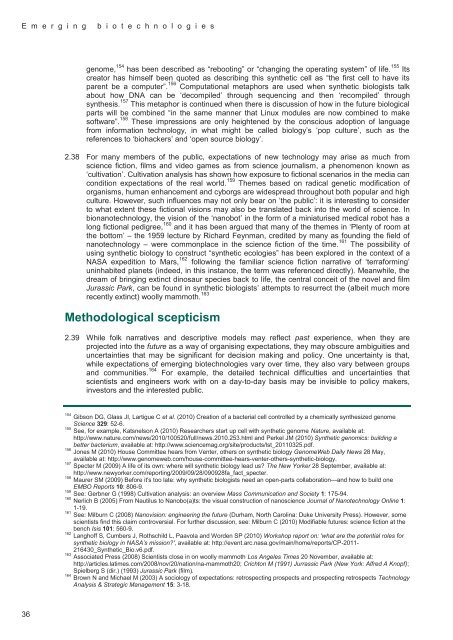Emerging biotechnologies: full report - Nuffield Council on Bioethics
Emerging biotechnologies: full report - Nuffield Council on Bioethics
Emerging biotechnologies: full report - Nuffield Council on Bioethics
You also want an ePaper? Increase the reach of your titles
YUMPU automatically turns print PDFs into web optimized ePapers that Google loves.
E m e r g i n g b i o t e c h n o l o g i e s<br />
genome, 154 has been described as “rebooting” or “changing the operating system” of life. 155 Its<br />
creator has himself been quoted as describing this synthetic cell as “the first cell to have its<br />
parent be a computer”. 156 Computati<strong>on</strong>al metaphors are used when synthetic biologists talk<br />
about how DNA can be ‘decompiled’ through sequencing and then ‘recompiled’ through<br />
synthesis. 157 This metaphor is c<strong>on</strong>tinued when there is discussi<strong>on</strong> of how in the future biological<br />
parts will be combined “in the same manner that Linux modules are now combined to make<br />
software”. 158 These impressi<strong>on</strong>s are <strong>on</strong>ly heightened by the c<strong>on</strong>scious adopti<strong>on</strong> of language<br />
from informati<strong>on</strong> technology, in what might be called biology’s ‘pop culture’, such as the<br />
references to ‘biohackers’ and ‘open source biology’.<br />
2.38 For many members of the public, expectati<strong>on</strong>s of new technology may arise as much from<br />
science ficti<strong>on</strong>, films and video games as from science journalism, a phenomen<strong>on</strong> known as<br />
‘cultivati<strong>on</strong>’. Cultivati<strong>on</strong> analysis has shown how exposure to ficti<strong>on</strong>al scenarios in the media can<br />
c<strong>on</strong>diti<strong>on</strong> expectati<strong>on</strong>s of the real world. 159 Themes based <strong>on</strong> radical genetic modificati<strong>on</strong> of<br />
organisms, human enhancement and cyborgs are widespread throughout both popular and high<br />
culture. However, such influences may not <strong>on</strong>ly bear <strong>on</strong> ‘the public’: it is interesting to c<strong>on</strong>sider<br />
to what extent these ficti<strong>on</strong>al visi<strong>on</strong>s may also be translated back into the world of science. In<br />
bi<strong>on</strong>anotechnology, the visi<strong>on</strong> of the ‘nanobot’ in the form of a miniaturised medical robot has a<br />
l<strong>on</strong>g ficti<strong>on</strong>al pedigree, 160 and it has been argued that many of the themes in ‘Plenty of room at<br />
the bottom’ – the 1959 lecture by Richard Feynman, credited by many as founding the field of<br />
nanotechnology – were comm<strong>on</strong>place in the science ficti<strong>on</strong> of the time. 161 The possibility of<br />
using synthetic biology to c<strong>on</strong>struct “synthetic ecologies” has been explored in the c<strong>on</strong>text of a<br />
NASA expediti<strong>on</strong> to Mars, 162 following the familiar science ficti<strong>on</strong> narrative of ‘terraforming’<br />
uninhabited planets (indeed, in this instance, the term was referenced directly). Meanwhile, the<br />
dream of bringing extinct dinosaur species back to life, the central c<strong>on</strong>ceit of the novel and film<br />
Jurassic Park, can be found in synthetic biologists’ attempts to resurrect the (albeit much more<br />
recently extinct) woolly mammoth. 163<br />
Methodological scepticism<br />
2.39 While folk narratives and descriptive models may reflect past experience, when they are<br />
projected into the future as a way of organising expectati<strong>on</strong>s, they may obscure ambiguities and<br />
uncertainties that may be significant for decisi<strong>on</strong> making and policy. One uncertainty is that,<br />
while expectati<strong>on</strong>s of emerging <str<strong>on</strong>g>biotechnologies</str<strong>on</strong>g> vary over time, they also vary between groups<br />
and communities. 164 For example, the detailed technical difficulties and uncertainties that<br />
scientists and engineers work with <strong>on</strong> a day-to-day basis may be invisible to policy makers,<br />
investors and the interested public.<br />
154 Gibs<strong>on</strong> DG, Glass JI, Lartigue C et al. (2010) Creati<strong>on</strong> of a bacterial cell c<strong>on</strong>trolled by a chemically synthesized genome<br />
Science 329: 52-6.<br />
155 See, for example, Katsnels<strong>on</strong> A (2010) Researchers start up cell with synthetic genome Nature, available at:<br />
http://www.nature.com/news/2010/100520/<str<strong>on</strong>g>full</str<strong>on</strong>g>/news.2010.253.html and Perkel JM (2010) Synthetic genomics: building a<br />
better bacterium, available at: http://www.sciencemag.org/site/products/lst_20110325.pdf.<br />
156 J<strong>on</strong>es M (2010) House Committee hears from Venter, others <strong>on</strong> synthetic biology GenomeWeb Daily News 28 May,<br />
available at: http://www.genomeweb.com/house-committee-hears-venter-others-synthetic-biology.<br />
157 Specter M (2009) A life of its own: where will synthetic biology lead us? The New Yorker 28 September, available at:<br />
http://www.newyorker.com/<str<strong>on</strong>g>report</str<strong>on</strong>g>ing/2009/09/28/090928fa_fact_specter.<br />
158 Maurer SM (2009) Before it's too late: why synthetic biologists need an open-parts collaborati<strong>on</strong>—and how to build <strong>on</strong>e<br />
EMBO Reports 10: 806-9.<br />
159 See: Gerbner G (1998) Cultivati<strong>on</strong> analysis: an overview Mass Communicati<strong>on</strong> and Society 1: 175-94.<br />
160 Nerlich B (2005) From Nautilus to Nanobo(a)ts: the visual c<strong>on</strong>structi<strong>on</strong> of nanoscience Journal of Nanotechnology Online 1:<br />
1-19.<br />
161 See: Milburn C (2008) Nanovisi<strong>on</strong>: engineering the future (Durham, North Carolina: Duke University Press). However, some<br />
scientists find this claim c<strong>on</strong>troversial. For further discussi<strong>on</strong>, see: Milburn C (2010) Modifiable futures: science ficti<strong>on</strong> at the<br />
bench Isis 101: 560-9.<br />
162 Langhoff S, Cumbers J, Rothschild L, Paavola and Worden SP (2010) Workshop <str<strong>on</strong>g>report</str<strong>on</strong>g> <strong>on</strong>: 'what are the potential roles for<br />
synthetic biology in NASA’s missi<strong>on</strong>?', available at: http://event.arc.nasa.gov/main/home/<str<strong>on</strong>g>report</str<strong>on</strong>g>s/CP-2011-<br />
216430_Synthetic_Bio.v6.pdf.<br />
163 Associated Press (2008) Scientists close in <strong>on</strong> woolly mammoth Los Angeles Times 20 November, available at:<br />
http://articles.latimes.com/2008/nov/20/nati<strong>on</strong>/na-mammoth20; Cricht<strong>on</strong> M (1991) Jurrassic Park (New York: Alfred A Knopf);<br />
Spielberg S (dir.) (1993) Jurassic Park (film).<br />
164 Brown N and Michael M (2003) A sociology of expectati<strong>on</strong>s: retrospecting prospects and prospecting retrospects Technology<br />
Analysis & Strategic Management 15: 3-18.<br />
36
















